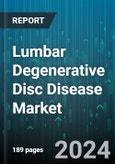Speak directly to the analyst to clarify any post sales queries you may have.
The lumbar degenerative disc disease market is undergoing significant transformation, propelled by rapid clinical innovation, digital health integration, and evolving regulatory frameworks. Senior decision-makers must align strategies and investments to address new opportunities and navigate increasing operational and reimbursement complexities.
Market Snapshot: Strategic Outlook on the Lumbar Degenerative Disc Disease Market
Achieving robust growth, the lumbar degenerative disc disease market responds to heightened demand for less invasive procedures and advanced therapeutics. The adoption of digital health solutions is actively reshaping patient care delivery, providing providers with expanded options for remote monitoring and enhanced therapy accessibility. Organizations across healthcare are also adjusting to new reimbursement models and heightened compliance obligations, influencing both infrastructure planning and investment in clinical capabilities. As digital integration accelerates, executive leaders must foster agility and anticipate shifts in the competitive landscape, tailoring approaches to meet regional differences and dynamic patient requirements.
Scope & Segmentation
This comprehensive executive report organizes the lumbar degenerative disc disease market across multiple actionable dimensions, empowering leadership with deep visibility into underlying drivers:
- Treatment Types: Includes non-surgical approaches (epidural injections, nerve blocks, radiofrequency ablation, pharmaceuticals, physical therapies) and surgical solutions (disc replacement, minimally invasive procedures, percutaneous techniques, spinal fusion). This segmentation supports executives in responding to the sustained shift toward minimally invasive therapies.
- Product Categories: Covers bone grafts (autograft, allograft, synthetic materials), orthobiologics, growth factors, platelet-rich plasma, stem cell therapies, spinal implants, and specialized surgical devices. Understanding distinct product lines enhances supply chain efficiency and sharper R&D allocation.
- End Users: Analyzes hospitals, ambulatory surgery centers, and specialty clinics, emphasizing how clinical environments influence operational workflows, procurement, and patient management.
- Insurance & Payment: Appraises private payers, public insurers, and the uninsured, clarifying how these segments affect access, compliance strategies, and revenue optimization.
- Demographic Groups: Examines patient cohorts divided by age, guiding targeted risk mitigation and the creation of tailored, population-specific clinical pathways.
- Regional Coverage: Assesses Americas, Europe, Middle East, Africa, and Asia-Pacific, evaluating differences in technology adoption, local regulatory contexts, and health system maturity to inform market entry and growth tactics.
- Leading Companies: Profiles leading organizations such as Medtronic plc, DePuy Synthes, Stryker Corporation, Zimmer Biomet Holdings, NuVasive, Globus Medical, Orthofix Medical, SeaSpine Holdings, RTI Surgical Holdings, and Alphatec Holdings, mapping their innovation priorities and competitive strategies.
Key Takeaways for Strategic Leadership
- Combining minimally invasive and biologically based treatments aligns operational models with shifting patient preferences and preparedness for outcome-driven reimbursement structures.
- Adopting digital health platforms, including tele-rehabilitation and remote patient tracking, supports the decentralization of care and strengthens executive oversight through real-time, data-driven decision-making.
- Aligning business processes with country- or region-specific reimbursement practices allows for greater agility when navigating regulatory and payer variability and supports informed expansion or adaptation.
- Building reliable supplier relationships and resilient supply chains ensures preparedness against economic disruptions, price volatility, and policy changes impacting device and biologic sourcing.
- Working alongside advocacy organizations enables patient-centric care co-development and fosters ethical compliance as stakeholder influence grows in regulatory considerations.
- Staying responsive to demographic change and regional growth, particularly in younger patient groups and regions like Asia-Pacific, allows for continual portfolio adjustment and improved resource allocation.
Tariff Impact on the Treatment Ecosystem
Recent changes in United States trade policy have driven up costs for vital diagnostic tools, spinal implants, and biologic therapies in the treatment ecosystem. As a direct response, healthcare providers are refining their procurement practices, strengthening domestic supply networks, and cultivating strategic partnerships. These measures enhance cost predictability and minimize the risk of supply disruptions, sustaining operational stability in a volatile economic environment.
Methodology & Data Sources
This report synthesizes findings from rigorous secondary research, extensive clinical trial analysis, regulatory document review, and patent tracking. Every key recommendation and analytic insight is validated by clinical leaders, supply chain professionals, and reimbursement experts to ensure strategic alignment with executive operational priorities.
Why This Report Matters
- Equips leadership with concrete intelligence to address digital health integration, evolving regulatory demands, and payment changes across all major global markets.
- Facilitates executive action through targeted insights, supporting business model innovation, adaptive risk management, and enduring market positioning.
- Delivers precise, segment-level analysis to sharpen planning, operational execution, and geographic expansion initiatives.
Conclusion
Success in the lumbar degenerative disc disease market relies on proactively aligning with clinical progress and operating flexibly. Ongoing policy tracking and robust supplier relationships are essential as the healthcare sector continues to evolve.
Additional Product Information:
- Purchase of this report includes 1 year online access with quarterly updates.
- This report can be updated on request. Please contact our Customer Experience team using the Ask a Question widget on our website.
Table of Contents
3. Executive Summary
4. Market Overview
7. Cumulative Impact of Artificial Intelligence 2025
Companies Mentioned
The companies profiled in this Lumbar Degenerative Disc Disease market report include:- Medtronic plc
- DePuy Synthes, Inc.
- Stryker Corporation
- Zimmer Biomet Holdings, Inc.
- NuVasive, Inc.
- Globus Medical, Inc.
- Orthofix Medical Inc.
- SeaSpine Holdings Corporation
- RTI Surgical Holdings, Inc.
- Alphatec Holdings, Inc.
Table Information
| Report Attribute | Details |
|---|---|
| No. of Pages | 197 |
| Published | October 2025 |
| Forecast Period | 2025 - 2032 |
| Estimated Market Value ( USD | $ 855.87 Million |
| Forecasted Market Value ( USD | $ 1400 Million |
| Compound Annual Growth Rate | 7.3% |
| Regions Covered | Global |
| No. of Companies Mentioned | 11 |









